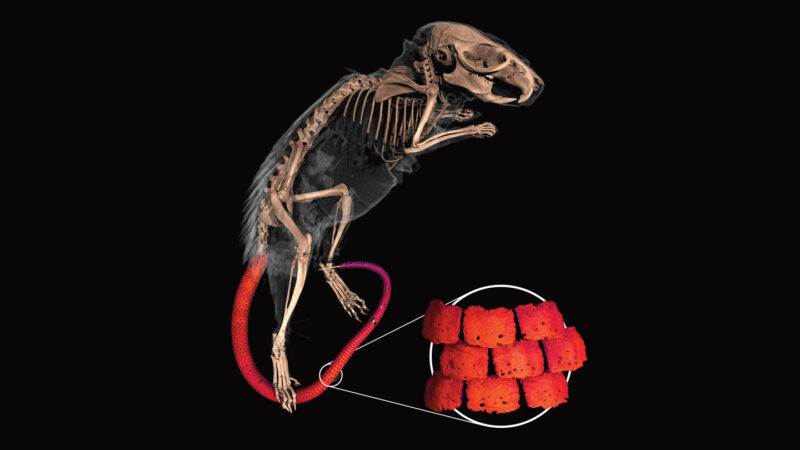
The spiny mouse is an unassuming rodent, but it’s armed with a very special tail.
CT scans show the tail is sheathed in a secret blanket of bony plates. Before the scans, only one other group of modern mammals was known to wield this kind of armor: armadillos. The discovery, reported May 24 in iScience, may mean that the skin bones are more widespread in mammals than previously thought and could shed light on their evolution.
The rodent’s secret was revealed when evolutionary biologist Edward Stanley of the Florida Museum of Natural History in Gainesville put a museum specimen of a spiny mouse (Acomys spp.) in an X-ray machine as part of a multi-institutional project to develop 3-D digital models of all vertebrate life.
It was a “nondescript looking” mouse with slightly spiky fur, Stanley says. But in the initial X-ray, its tail looked unusual. “It looked kind of dark and weird,” he says.
A more detailed CT scan showed the mouse’s whole tail was covered in overlapping bony plates within the skin, under the surface layers.
To understand how the bony plates develop, Stanley and his colleagues teamed with Malcolm Maden, a developmental biologist at the University of Florida. The team scanned the tails of newborn spiny mice up to those that were 6 weeks old. Bony plates form first near the base of the tail and then as the mouse ages, grow down the tail to its tip. CT scans revealed that three other species in the same subfamily as the spiny mouse also have armor-studded tails.
These bony plates, called osteoderms, may help keep spiny mice and their relatives alive. The rodents’ skin is especially fragile and easily tears off, particularly on the tail. It’s hypothesized that the tearaway skin is a macabre defense, where attacking predators are left with a mouthful or paw full of shed skin. The plates may prevent predators from piercing too deep.
“If you can stop the teeth or the claws of your predator at the tearaway boundary, then it’s much easier to get away,” Stanley explains. The mice regenerate the lost skin later.
But the tail’s skin bones might protect against more than just predators. For some reason, spiny mice routinely bite each other’s tails, says Ashley Seifert, a developmental biologist at the University of Kentucky in Lexington. “So maybe they have evolved osteoderms as armament, but to defend their tails from each other instead of predators.”
To better understand the biological underpinnings of the bony skin, the researchers took skin samples from the tails of newborn spiny mice in places with and without osteoderms and analyzed gene activity.
In skin samples with osteoderms, the activity of a suite of genes associated with bone cell development was boosted compared with samples without osteoderms. But the activity of genes that make keratin, a key building block for skin, was ramped down. The next step, Maden says, is to see how all these genes actually grow the osteoderms.
The research could help provide insights into osteoderm evolution. Bony skin is found in a variety of reptile groups, having evolved independently in crocodilians, many different lizard groups and some dinosaurs (but no birds) (SN: 12/6/22). Madagascar’s fish-scaled geckos have osteoderms and shed skin like spiny mice. Aside from the rodents in the new study and armadillos, the only other known mammals with bony skin are all extinct: an ancient hedgehog-like animal called Pholidocercus, ground sloths and armadillo relatives called glyptodonts (SN: 2/22/16).
Delving into gene activity patterns is rarely done in osteoderm research, says Chris Broeckhoven, an evolutionary biologist at the University of Antwerp in Belgium. Having this comparative data from mice available could yield key evolutionary insights.
One key insight, Maden says, could be “why [osteoderms] keep appearing in evolution and then disappear.”
It’s also possible osteoderms are more common among vertebrates than previously thought. No snakes were known to have the bony skin and then in April researchers reported finding them in sand boas.
These discoveries are “a good example of how you should look at the world around you,” Maden says. “Who knows what you will discover.”


